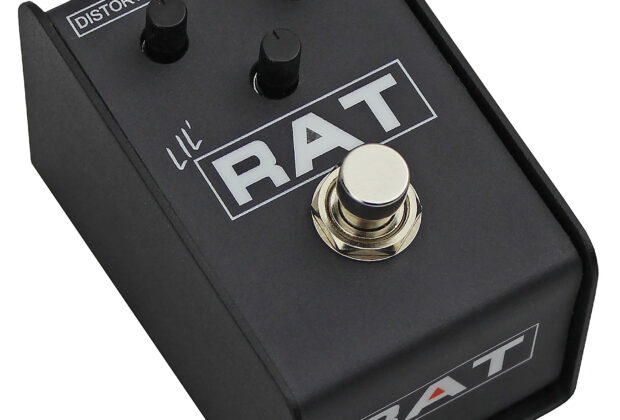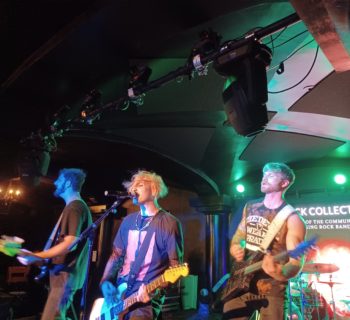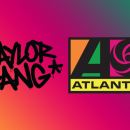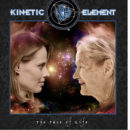The ProCo RAT is arguably one of the most popular distortion guitar effect pedals ever created, right up there with such venerable stomp boxes as the Ibanez Tube Screamer and the BOSS DS-1. If you are a guitar player, chances are you have owned or at least played through a RAT distortion pedal at least once in your career.
Since it was originally created back in 1978, the RAT has evolved from a single, hand-built prototype into a family of versatile guitar effect pedals and has been in continuous production for almost 50 years. During that time, there have been many different RAT variations with many different components and features. Actually, the RAT brand has been owned by several different companies over the years including ProCo, RapcoHorizon and ACT Entertainment, which currently offers a full range of authentic RAT pedals. Included among these are the Deucetone RAT and Lil’ RAT, which sit at either end of the current RAT product line-up. More on those two stompboxes later, but first, a little background.
Back in 1978, the original design goal of the RAT was to create a brand-new distortion sound that would cut through the mix on stage without being too over the top. The signature RAT sound, which was discovered purely by accident, is produced by a single op-amp and a variable-gain circuit with silicon diodes that short the output to ground, thereby clipping the source material. The key to the RAT’s sound is that the circuits’ op-amp circuit is run at such a high rate that it starts distorting even before the signal hits the diodes resulting in a clipping effect. As it was discovered, clipping the diodes allows the guitarist to create complex harmonic effects ranging from low-gain distortion to heavy fuzz, all in a single guitar effect pedal.
While there have been many different RAT variations created over the years, almost all share some common features including an all-analog signal path; military-spec glass-epoxy circuit board housed in a virtually indestructible steel enclosure; heavy-duty, industrial grade footswitches, knobs, and jacks; an easy to see on/off LED indicator; a sloped face for easy switching; an AC jack; and a “no tools required” battery compartment. Most RATs over the years have also sported a glow-in-the-dark logo. In short, the RAT has always been built like a tank and designed to take a significant amount of real-world abuse and keep on rocking.
Back in 1981, the RAT designers at ProCo substituted the tone control for a low pass filter circuit labeled “filter,” which has become an integral part of the RAT signature sound since that time. From a user standpoint, the filter control acts as a kind of a reverse tone knob, meaning turning it to the right rolls off brittle high-end frequencies while turning it to the left allows the natural tones of your guitar to come through. This means turning the filter knob clockwise will decrease the treble rather than increasing it as would be the case with a typical tone control. Almost all the current RAT models still feature the classic three-knob control setup, which includes filter, distortion and volume controls as well as true bypass switching.
Designed to offer the full tonal spectrum of the current RAT product range, the Deucetone ‘s origins come from a dual RAT rack-mounted unit from the ’80s called the R2DU. Now housed in a floor pedal, the Deucetone RAT consists of two completely independent ProCo RAT units. Each Deucetone RAT channel can be used separately, in stereo, or cascaded together for a virtually unlimited palette of tones, and each is switchable between three RAT settings. Channel A features the Vintage RAT, Turbo RAT and Dirty RAT, while Channel B gives you the choice of Vintage RAT, Turbo RAT, or Clean RAT tones. The Clean RAT is a clean boost, available only in the Deucetone RAT. Playing through a Deucetone RAT is like having six RAT pedals in one effect unit. Used separately or with both channels cascaded, you have 15 RAT tones at your feet. As with all the other variations in the current RAT product line up, the Deucetone RAT pedal features the classic RAT filter control, which has been an essential part of the RAT design topology since 1981.
At the other end of the product range sits the smallest RAT pedal to date, the Lil’ RAT, which succeeds in distilling the essence of the RAT topology into a desktop or gig bag-friendly footprint and is available at an extremely cost-effective price. The Lil’ RAT delivers exactly what you would expect: namely a RAT pedal in a smaller enclosure. It has the same controls, tone and dynamics of the larger versions in a smaller footprint. If you are looking to get the full capability of the RAT in a smaller pedalboard-friendly enclosure, then the Lil’ RAT may be just what you are looking for.
Having owned several variations of the RAT pedal over the years, I can confirm that the sound from the typical RAT pedal resides somewhere between a distortion pedal and a fuzz box. I really like the RAT’s filter control, which gives you the ability to dial back the overall effect to almost zero and then ramp it up for some truly over the top distortion and fuzz effects. Another feature I like in the RAT is its ability to emulate the natural sag of a tube amp.
Many digital emulations of the RAT have been developed over the years. While convenient to use in as plug-in format, when compared side-by-side, the old school all-analog RAT stomp box plugged into the front end of your tube amp is still a tough combination to beat. If you have never had the opportunity to play through a RAT, check one out at your local dealer; you won’t be disappointed.
The Deucetone RAT is available now for $299.99 and the Lil’ RAT is available now for $79.99.
Find out more at ratdistortion.com













